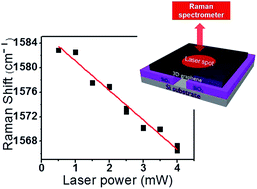Thermal conductivity reduction in three dimensional graphene-based nanofoam†
Abstract
This work investigates the thermoelectric properties of a three dimensional nanofoam of few layer graphene (3D-NFG) decorated with holes having diameter of several tens of nanometer. The nanoporous 3D graphene structures were fabricated by a chemical vapor deposition method to ensure high electrical conductivity required for potential applications as thermoelectric materials. The thermal conductivity of the suspended 3D-NFG samples was measured by an optothermal method and found to be 10.8 W m−1 K−1. The substantially reduced values of thermal conductivity were attributed to the small diameter of the pores and their inhomogeneous distribution. Suppression of heat conduction with preserved electrical conductivity is beneficial for the proposed thermoelectric applications.


 Please wait while we load your content...
Please wait while we load your content...